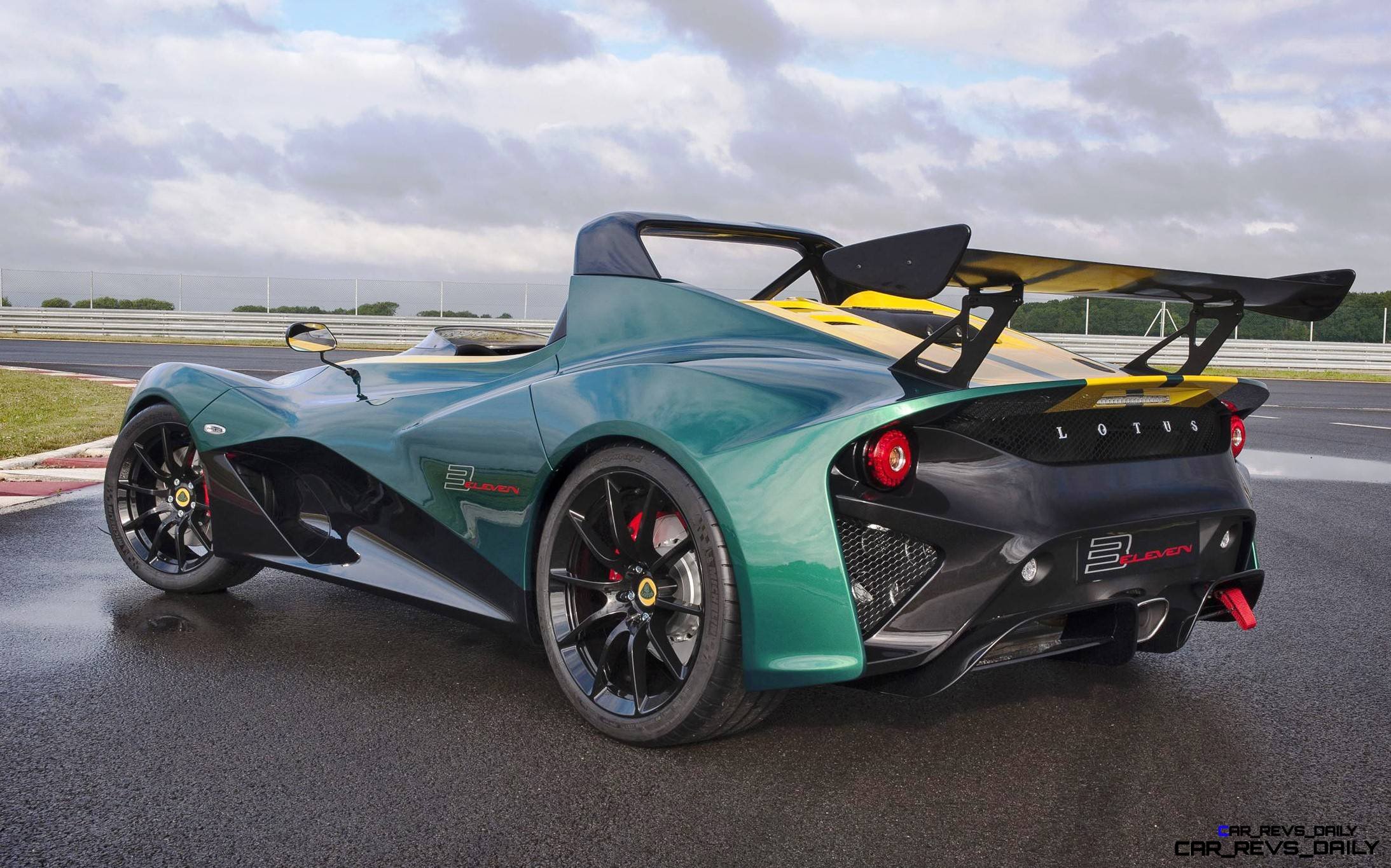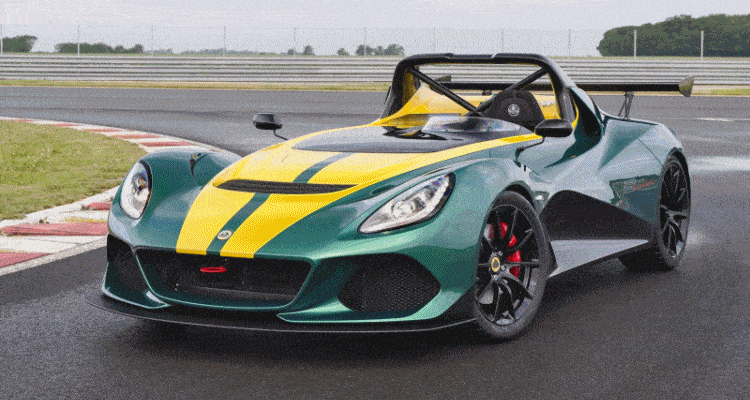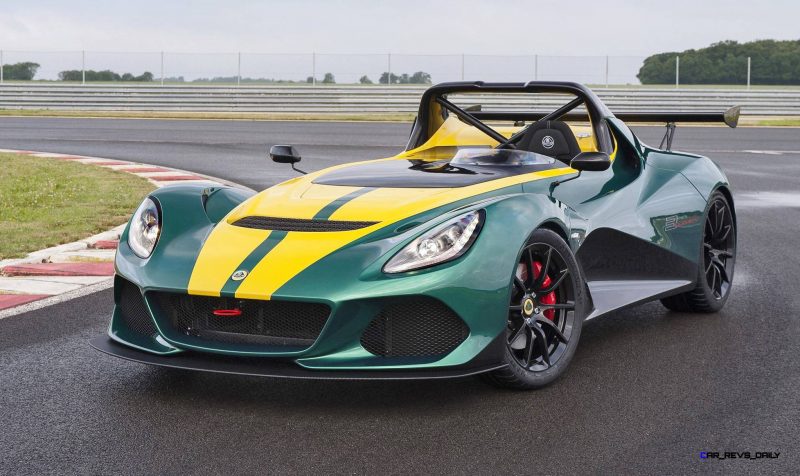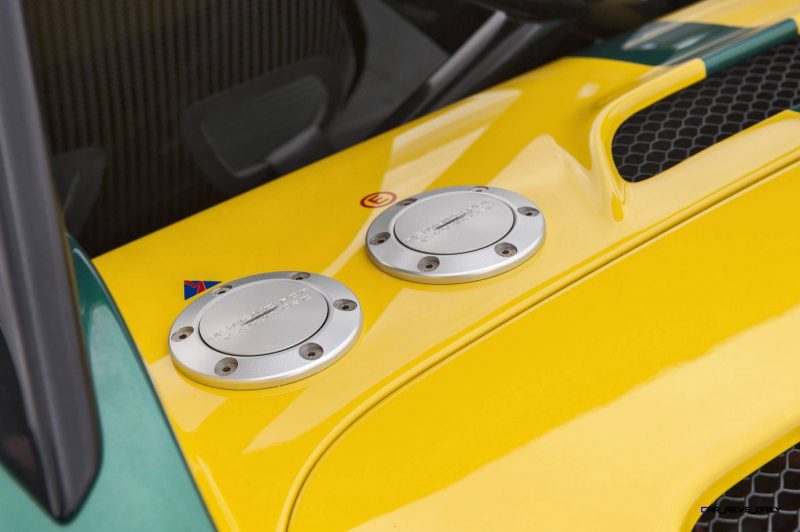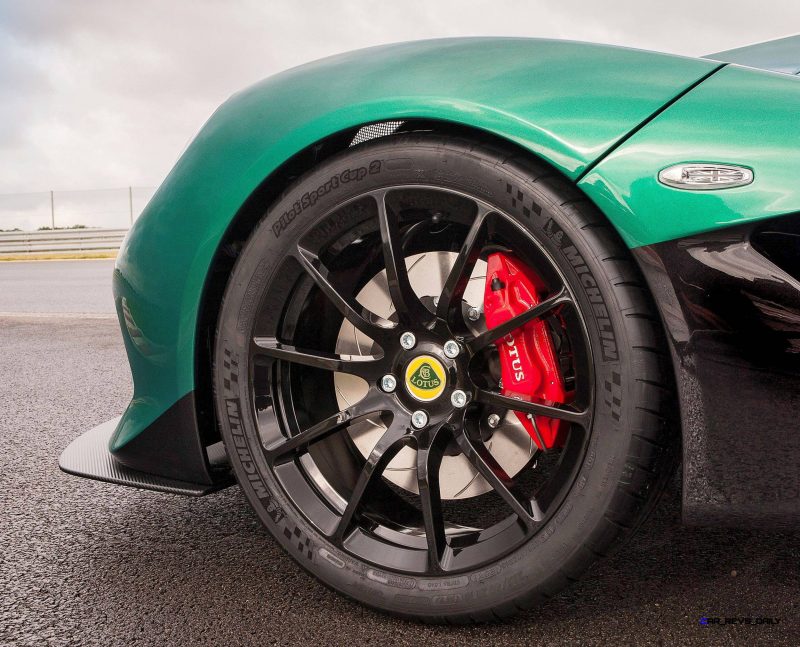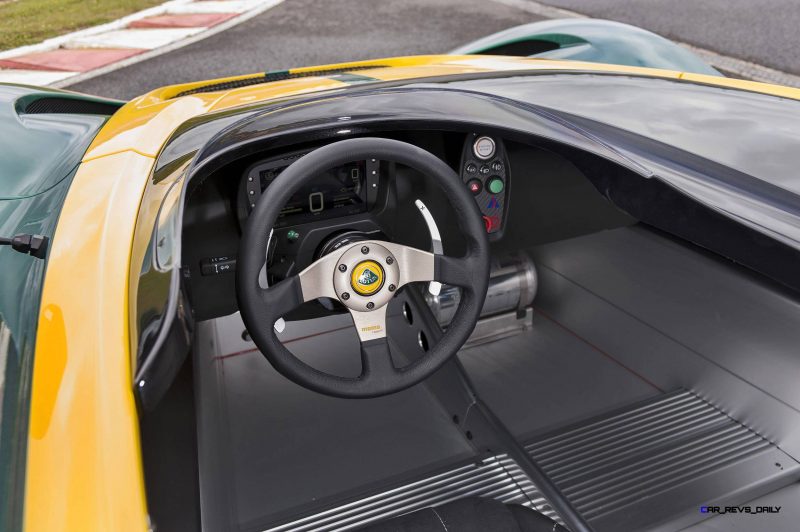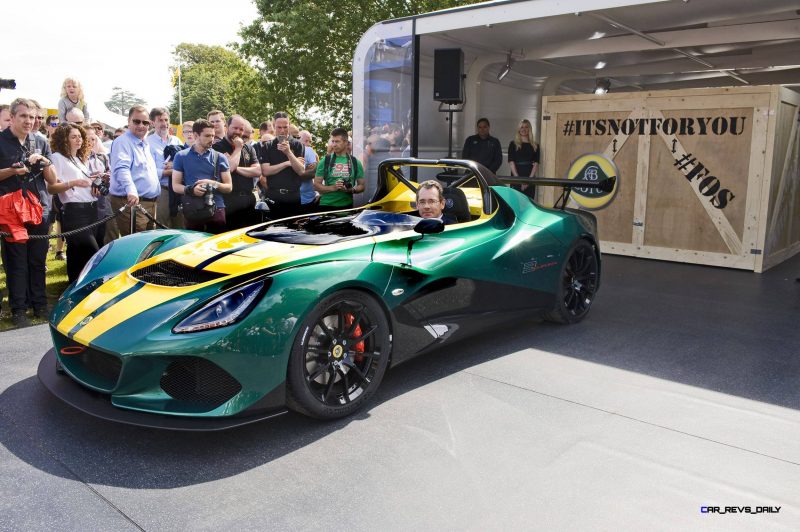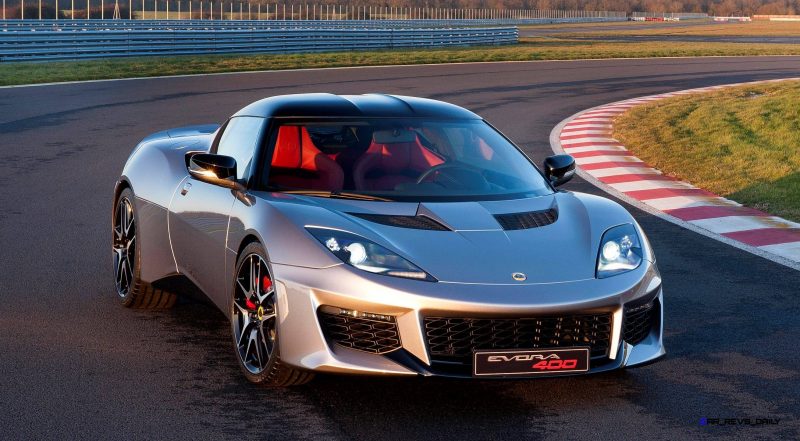Lotus founder Colin Chapman always preached about the benefits of ‘adding lightness’ to achieve the quickest possible laptimes.
But what if you could add lightness actively and passively. Passively, you could strip away the entire windshield and roof of an Exige V6.
‘Active lightness’ is a fairly new idea for Lotus track cars, but one that will make this new 3-Eleven the quickest production model ever to leave Hethel.
The stripped-down track focus for the 3-Eleven is paired with a 450-horsepower supercharged V6 and wild, expressive concept-car slashes in the all-new profile and tail designs. But the power will be most memorable. 450 dry-sumped ponies make this by far the *lightest* Lotus of all time in terms of achieving hypercar performance at 911 Carrera prices.
The 2016 Lotus 3-Eleven will be offered in two hardcore variants, the Road and Race.
Production will start in February 2016 with a price for the Road variant coming in at Pounds 82k, up to Pounds 96k for the Race version. The new Evora 400 comes in with a base price of just 72k in the UK, for comparison.
A six-speed manual will be standard on the Road model, but this flips to a competition-spec sequential manual for the 3-Eleven Race. Slick tires and even more performance tuning for the LSD and suspension make the Race a giant-killer with over 500 horsepower per pound.
Just 311 units will be produced, with global sales possible for track-only purists. English and other lucky ducks will be able to drive the 3-Eleven Road version legally on the roads. The mini visor of a windshield means a helmet will be recommended in the single-seat cockpit.
Probably the best way to stay safe, plus to keep bugs out of your giant grin at the wheel!
It is an exciting time for Lotus USA as well, with new dealerships popping up and the Evora 400 arriving to the first US buyers around September of this year.
2016 Lotus 3-Eleven
The all new Lotus 3-Eleven
- The quickest production Lotus road car ever
- Dramatic, all-new lightweight composite body
- Two versions, Road and Race, both developed through Lotus Motorsport
Heralding a new generation of Lotus high performance sports cars, today saw the unveiling of the company’s quickest and most expensive series production car ever, the 3-Eleven, at the 2015 Goodwood Festival of Speed.
Designed as an uncompromised manifestation of the Lotus spirit, the new car is focused on providing an undiluted driving experience, and underlines the company’s ability to deliver legendary handling and blistering speed.
Working on the concept of less is more, and keeping close to Lotus’ track roots, the dramatic new vehicle features an all-new lightweight body, with an open cockpit design and a revised V6 supercharged engine developing 450 hp.
Two variations of the Lotus 3-Eleven will be available: Road and Race; both delivering an impressive combination of high performance, agility and precision. Based on the Road version, the Race includes a more aggressive aero kit, a sequential gearbox and an FIA approved driver’s seat with a six-point harness.
With a dry weight of below 900 kg (Race version), the 3-Eleven offers an enviable power to weight ratio, in excess of 500 hp per tonne, and is capable of sprinting from 0-60 mph in less than 3.0 seconds before reaching a maximum speed of 174 mph (280 km/h) for the Race version and 180 mph (290 km/h) for the Road version
Speaking at Goodwood, Jean-Marc Gales, Chief Executive Officer for Group Lotus plc, stated, “We always say that to make a sports car better, you make it faster and lighter. The new Lotus 3-Eleven carries that philosophy to a new level, and is perfectly in keeping with our brand values.”
Jean-Marc Gales continued, “This new car is a giant slayer, capable of embarrassing far more expensive rivals. It condenses our engineering know-how into one, hard-core package, and is so focused that it won’t suit everyone. This is a perfect demonstration of the faster and lighter concept, something which will be crucial to all Lotus cars in the future.”
The new Lotus 3-Eleven will enter production in February 2016 and deliveries will commence in April 2016. Production will be limited to just 311 vehicles in total.
Prices start at £82,000 for the Road version (including VAT and on the road costs) and £96,000 excluding VAT for the Race version (£115,200 including VAT).
The Lotus 3-Eleven in more detail:
Performance
- Quickest Lotus production car ever, lapping the Hethel track in 1 min 22 secs
- Aerodynamic downforce of up to 215 kg at 150 mph (240 km/h) – Race version
The 3-Eleven utilises a bespoke chassis based on the proven Lotus design of extruded and bonded aluminium sections. The Road roll-cage incorporates twin side bars for side impact protection, whilst the Race cage has additional bars to meet international requirements for motorsport.
The Lotus 3-Eleven’s suspension features lightweight, double-wishbones front and rear, adjustable front anti-roll bar and Eibach springs with Öhlins adjustable dampers. This allows owners to fine tune the vehicle’s handling characteristics.
Powertrain
- Supercharged and charge-cooled 3.5-litre V6 engine
- Limited Slip Differential as standard
- Lotus traction control system
The new Lotus 3-Eleven is powered by a revised version of the 3.5-litre V6 engine first shown in the Evora 400, which includes a supercharger with integrated water-to-air charge cooler. Maximum power output has increased to 450hp (456 PS / 336 kW) at 7000 rpm and torque has increased to 450 Nm / 332 lbs ft with maximum torque available from 3500 rpm through to 6500 rpm.
A close-ratio six-speed manual gearbox with a Torsen-type limited slip differential, featuring a performance clutch assembly and oil cooler, come as standard on the Road version. The Race model has a 6-speed sequential transmission with a semi-dry sump, oil cooler, limited slip differential and paddle shift.
Brakes and Tyres
- Lightweight forged Aluminium wheels as standard
- AP Racing four-pot calipers
- Bosch ABS tuned by Lotus
Designed to cope with the 3-Eleven’s potential, lightweight forged Aluminium wheels are fitted as standard on the 3-Eleven, with either Michelin Pilot Super Sport or Michelin Cup 2 tyres depending on if it’s in Road or Race configuration.
At the front 225/40 ZR18 tyres are standard, and to help transfer the 3-Eleven’s considerable power and torque to the road, the rear tyres has been specified as 275/35 ZR19.
In order to deliver the stopping power required for such a quick car, AP Racing four-piston calipers are complemented by two-part grooved and vented brake discs (332 mm front and rear). Upgraded brake pads are fitted to the Race version.
Exterior Design
- Lightweight body panels, using new resin infusion composite technology
- Dramatic silhouette underlines car’s performance-focused nature
Manufactured from very light weight composite materials, optimizing vehicle weight, aerodynamic and structural requirements, the 3-Eleven’s composite body is 40% lighter than the GRP equivalent.
This new process is a first for a production car, and an example of Lotus’ focus on utilising pioneering new technology and lightweight materials in its vehicles. The choice of material technology has allowed extreme vehicle performance targets to be met, and help realise the 3-Eleven’s dynamic styling.
Undeniably a track car, the 3-Eleven’s aggressive stance leaves no doubt of its intentions. The dramatically sculpted body perfectly balances the technical efficiency of a track car with the surface refinement of a road-going supercar. Form follows function, with a minimised cross sectional area that keeps drag to a minimum while optimising cooling.
As an extreme design evolution of Lotus predecessors, the Lotus 3-Eleven’s new front clam shell incorporates larger openings to deliver the necessary cooling for the powertrain and transmission. This helps give the vehicle a much more aggressive stance.
Two front splitter configurations are available, depending on whether the vehicle is configured for road or race use, and the front arches are wide enough to cover the car’s wide track and the new 225/40 ZR18 tyres.
Dramatic side scallops provide a clean exit from the front wheels arches, and the car’s profile is dominated by an aerodynamically significant roll bar cover. The car is without a windscreen and doors, with the roll bar fully enclosing the rear cage. As well as generating downforce, the roll bar forms a vital part of the car’s homologation to international motorsport safety standards.
The rear clamshell emphasises the aggressive stance of the car, with different fixed spoilers available, depending on whether the vehicle is specified for road or race use.
The new rear diffuser and under-tray, which has been developed to ensure minimum drag, complements an exhaust system designed specifically to minimize back pressure and enhance engine performance.
Interior Design
- Focussed race interior
- New race spec colour TFT instrument cluster can be switched between road and track modes
Fitted with the standard aeroscreen and the optional passenger seat, a passenger can be easily accommodated in the two seater. However, these can be removed and the optional tonneau panel fitted – to envelope the driver and improve overall aerodynamics.
The new instrument cluster has been designed around a colour TFT screen, and can be switched between road and track modes, providing relevant information direct to the driver.
A quick release steering wheel and Lotus sports seats with four-point harnesses are fitted as standard, while the Race variant has the option of a data logger system, FIA approved driver’s race seat, and six-point harness – as well as a fire extinguisher & battery kill switch.
Manufacturing
- Hand built in Hethel, England
The Lotus 3-Eleven will be hand made by the highly skilled craftsmen and women at the Lotus Headquarters in Hethel, alongside the rest of the Lotus sports car range, supported by Lotus Motorsport technicians. All 3-Elevens will then be finished in Lotus Motorsport’s dedicated workshops prior to delivery.
Official fuel consumption figures and CO2 emissions figures for the Lotus 3-Eleven are not available at the time of going to press. They will be provided on the Lotus website www.lotuscars.com as soon as they are available.

Tom Burkart is the founder and managing editor of Car-Revs-Daily.com, an innovative and rapidly-expanding automotive news magazine.
He holds a Journalism JBA degree from the University of Wisconsin – Madison. Tom currently resides in Charleston, South Carolina with his two amazing dogs, Drake and Tank.
Mr. Burkart is available for all questions and concerns by email Tom(at)car-revs-daily.com.

